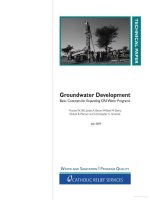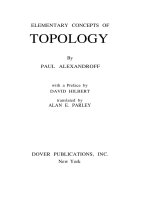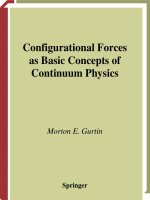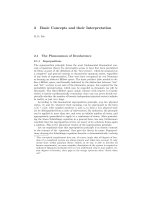Basic concepts in turbomachinery
Bạn đang xem bản rút gọn của tài liệu. Xem và tải ngay bản đầy đủ của tài liệu tại đây (4.42 MB, 144 trang )
Grant Ingram
Basic Concepts in Turbomachinery
Download free eBooks at bookboon.com
2
Basic Concepts in Turbomachinery
© 2009 Grant Ingram & Ventus Publishing ApS
ISBN 978-87-7681-435-9
Download free eBooks at bookboon.com
3
Basic Concepts in Turbomachinery
Contents
Contents
1
1.1
1.2
1.3
1.4
1.5
1.6
1.7
1.8
Introduction
How this book will help you
Things you should already know
What is a Turbomachine?
A Simple Turbine
The Cascade View
The Meridional View
Assumptions used in the book
Problems
16
17
17
17
18
19
23
23
24
2
2.1
2.2
2.3
2.4
2.5
Relative and Absolute Motion
1D Motion
2D Motion
Velocity Triangles in Turbomachinery
Velocity Components
Problems
25
26
27
28
30
33
3
3.1
3.2
3.3
Simple Analysis of Wind Turbines
Aerofoil Operation and Testing
Wind Turbine Design
Turbine Power Control
35
38
41
44
e Graduate Programme
for Engineers and Geoscientists
I joined MITAS because
I wanted real responsibili
Maersk.com/Mitas
Real work
International
Internationa
al opportunities
ree work
wo
or placements
Month 16
I was a construction
supervisor in
the North Sea
advising and
helping
foremen
he
solve
problems
s
Download free eBooks at bookboon.com
4
Click on the ad to read more
Contents
Basic Concepts in Turbomachinery
3.4
3.5
Further Reading
Problems
44
45
4
4.1
4.2
4.3
4.4
4.5
4.6
4.7
4.8
Different Turbomachines and Their Operation
Axial Flow Machines
Radial and Centrifugal Flow Machines
Radial Impellers
Centrifugal Impellers
Hydraulic Turbines
Common Design Choices
The Turbomachine and System
Problems
46
47
47
49
52
54
57
59
60
5
5.1
5.1.1
5.2
5.2.1
5.3
5.3.1
5.3.2
5.4
Application of The Equations of Fluid Motion
Conservation of Mass
Application to Radial Machines
Conservation of Momentum
The Difference Between a Single Aerofoil and a Cascade of Blades
Conservation of Energy and Rothalpy
Rothalpy
Rothalpy in Stators and Rotors
Problems
61
61
63
64
68
69
71
71
73
6
6.1
Efficiency and Reaction
Efficiency
74
74
www.job.oticon.dk
Download free eBooks at bookboon.com
5
Click on the ad to read more
Basic Concepts in Turbomachinery
Contents
6.1.1
6.1.2
6.2
6.3
6.4
Using Efficiency
Other Efficiency Definitions
Reaction
Reaction on the h − s Diagram
Problems
77
78
78
79
82
7
7.1
7.2
7.3
7.3.1
7.3.2
7.3.3
7.4
Dimensionless Parameters for Turbomachinery
Coefficients for Axial Machines
Coefficients for Wind Turbines
Coefficients for Hydraulic Machines
Specific Speed for Turbines
Specific Speed for Pumps
Using Specific Speeds
Problems
83
84
87
88
90
91
91
93
8
8.1
8.1.1
8.1.2
8.2
8.3
8.4
8.5
8.6
8.7
Axial Flow Machines
Reaction for Repeating Stage
Zero Reaction (Impulse) Stage
50% Reaction Stage
Loading and Efficiency Variation with Reaction
Stage Efficiency
Choice of Reaction for Turbines
Compressor Design
Multistage Steam Turbine Example
Problems
94
94
97
97
98
100
101
102
103
106
Download free eBooks at bookboon.com
6
Click on the ad to read more
Basic Concepts in Turbomachinery
Contents
9
9.1
9.2
9.3
9.4
9.4.1
9.4.2
9.4.3
9.5
Hydraulic Turbines
Pelton Wheel
Analysis Approach
Francis Turbine
Kaplan Turbine
Loss Estimation
Draft Tube Analysis
Effect of Draft Tube
Problems
108
109
110
110
116
120
121
123
124
10
10.0.1
10.1
10.2
10.3
10.4
10.4.1
10.5
10.6
Analysis of Pumps
Pump Geometry and Performance
Pump Diffuser Analysis
Pump Losses
Centrifugal Pump Example
Net Positive Suction Head (NPSH)
Cavitation Example
Application to Real Pumps
Problems
126
127
129
130
132
135
137
138
138
11
Summary
139
Appendix A: Glossary of Turbomachinery Terms
141
Appendix B: Picture Credits
144
Join the Vestas
Graduate Programme
Experience the Forces of Wind
and kick-start your career
As one of the world leaders in wind power solutions with wind turbine installations in over 65
countries and more than 20,000 employees
globally, Vestas looks to accelerate innovation
through the development of our employees’ skills
and talents. Our goal is to reduce CO2 emissions
dramatically and ensure a sustainable world for
future generations.
Read more about the Vestas Graduate
Programme on vestas.com/jobs.
Application period will open March 1 2012.
Download free eBooks at bookboon.com
7
Click on the ad to read more
List of Figures
Basic Concepts in Turbomachinery
List of Figures
1.1
1.2
1.3
1.4
1.5
1.6
1.7
Applications of Turbomachinery
A Simple Turbine
A Simple Turbine: Exploded View
Simple Turbine Operation
Cascade View
The Cascade View as a Large Radius Machine
Meridional View
18
20
20
21
21
22
24
2.1
2.2
2.3
2.4
2.5
2.6
2.7
Relative and Absolute Velocities for a Cyclist
Velocity Triangles for an Aircraft Landing
Graphical Addition and Subtraction of Vectors
Cascade and Meridional Views of a Turbine Stage
Velocity Triangles for a Turbine Stage
Velocity Triangles at Station 3 of a Turbine
Velocity Triangles for a Desk Fan
26
27
28
29
31
32
33
3.1
3.2
3.3
3.4
3.5
3.6
3.7
Wind Turbine Picture and Sketch
Wind Turbine Blade and Velocity Triangle
Forces on a Wind Turbine Blade
Aerofoil at Two Incidences
CL and CD for a NACA 0012 Aerofoil
Relationship between and i
Schematic Showing Wind Turbine Pitch Control
36
37
37
39
41
42
45
In Paris or Online
International programs taught by professors and professionals from all over the world
BBA in Global Business
MBA in International Management / International Marketing
DBA in International Business / International Management
MA in International Education
MA in Cross-Cultural Communication
MA in Foreign Languages
Innovative – Practical – Flexible – Affordable
Visit: www.HorizonsUniversity.org
Write:
Call: 01.42.77.20.66
www.HorizonsUniversity.org
Download free eBooks at bookboon.com
8
Click on the ad to read more
Basic Concepts in Turbomachinery
List of Figures
4.1
4.2
4.3
4.4
4.5
4.6
4.7
4.8
4.9
4.10
4.11
4.12
4.13
Radial Pump
3D View of the Radial Impeller
Centrifugal Impeller
The Cascade View for a Radial Impeller
Velocity Triangles for a Radial Impeller
Common errors in Velocity Triangles
Constructing the Cascade View for a Centrifugal Impeller
Velocity Triangles for a Centrifugal Impeller
Schematic of Hydro-Electric Scheme
The Four Major Types of Hydraulic Turbine
Pelton’s Patent Application and Analysis Model
Three Dimensional Views of a Francis Turbine
Three Dimensional Views of a Kaplan Turbine
48
48
49
50
50
52
53
54
55
56
58
58
59
5.1
5.2
5.3
5.4
5.5
Meridional View of a Gas Turbine
Meridional Views of Radial and Centrifugal Machines
A Generic Turbomachinery Flow Passage
Isolated Aerofoil compared to a Cascade
Generic Velocity Triangle
64
65
67
68
72
6.1
6.2
6.3
6.4
6.5
Enthalpy-Entropy Diagram for a Turbine
Enthalpy-Entropy Diagram for a Compressor
Basic h-s diagram
h-s diagram with h0
h-s diagram with h0 and h0rel
75
76
81
81
82
Are you remarkable?
Win one of the six full
tuition scholarships for
International MBA or
MSc in Management
Download free eBooks at bookboon.com
9
register
now
rode
www.Nyen
ge.com
n
le
al
h
MasterC
Basic Concepts in Turbomachinery
List of Figures
7.1
7.2
7.3
7.4
Velocity triangles for exit and inlet combined
CP vs for 2.5MW Wind Turbine
Collapsing Pump Data onto Non-dimensional Curves
Specific Speed for a Number of Hydraulic Turbines
85
89
89
93
8.1
8.2
8.3
8.4
h-s diagram with h0 and h0rel
Impulse and 50% Reaction Blading
Locations for Tip Clearance Flow
Schematics of Disc and Diaphragm Construction
95
98
101
102
9.1
9.2
9.3
9.4
9.5
9.6
9.7
Pelton’s Patent Application and Analysis Model
Analysis of a Francis Turbine
Velocity Triangle for Francis Turbine Guide Vane Exit
Velocity Triangle for Francis Runner Exit
Analysis of a Kaplan Turbine
Velocity Triangle for a Kaplan Turbine at Guide Vane Exit
Velocity Triangle for a Kaplan Runner
109
111
113
115
117
118
119
10.1
10.2
10.3
10.4
10.5
10.6
Three Blade Angles at Impeller Exit
H vs Q for Three Blade Angles
P vs Q for Three Blade Angles
Inlet to Pump Impeller
Exit from Pump Impeller
Pump Inlet
128
128
129
132
133
135
Do you have drive,
initiative and ambition?
Engage in extra-curricular activities such as case competitions, sports, etc. – make new friends among cbs’ 19,000
students from more than 80 countries.
See how we
work on cbs.dk
Download free eBooks at bookboon.com
10
Click on the ad to read more
Basic Concepts in Turbomachinery
Nomencalture
Nomenclature
A Area
b Blade height
c Chord length
CD Dissipation coefficient or drag coefficient
CL Lift coefficient
Cp Specific heat capacity at constant pressure or power coefficient for wind turbines
Cv Specific heat capacity at constant volume
D Machine diameter
g Acceleration due to gravity
Download free eBooks at bookboon.com
11
Click on the ad to read more
Basic Concepts in Turbomachinery
Nomencalture
h Enthalpy or static pressure head
H Total head
i Incidence angle
I Rothalpy
k Loss coefficient
K Dimensionless specific speed or loss coefficient
L Angular momentum
m
˙ Mass flow rate
N Rotation speed in revolutions per second or Dimensional specific speed
p Pressure
P Power
Q Flow rate
q Heat transfer
R Gas constant or Reaction or tip radius
r Radial coordinate
rm Mean radius
rt Tip radius
rh Hub radius
s Blade pitch or entropy
t Time or blockage factor
T Torques or temperature
U Frame velocity vector
U Frame velocity magnitude
V Absolute velocity vector
V Absolute velocity magnitude
W Relative velocity vector
w Work
W Relative velocity magnitude
x Axial coordinate
z Height
α Absolute flow angle
Download free eBooks at bookboon.com
12
Basic Concepts in Turbomachinery
Nomencalture
β Relative flow angle
γ Ratio Cp /Cv or blade inlet angle for wind turbines
Θ Angle made by Pelton wheel bucket
θ Tangential coordinate
λ Tip speed ratio for wind turbines
Π Dimensionless parameter
η Efficiency
ρ Density
μ Viscosity
σ Thoma’s parameter for cavitation
Φ Stage loading coefficient
ψ Flow coefficient
ω Rotational speed
Develop the tools we need for Life Science
Masters Degree in Bioinformatics
Bioinformatics is the
exciting field where biology,
computer science, and
mathematics meet.
We solve problems from
biology and medicine using
methods and tools from
computer science and
mathematics.
Read more about this and our other international masters degree programmes at www.uu.se/master
Download free eBooks at bookboon.com
13
Click on the ad to read more
Basic Concepts in Turbomachinery
Acknowledgements
Acknowledgements
This book is based on an introductory turbomachinery course at Durham University. This course
was taught by Dr David Gregory-Smith and Professor Li He over a number of years and I am extremely grateful to them for providing a clear and lucid set of principles on which to base this work.
My current colleagues at Durham Dr Rob Dominy and Dr David Sims-Williams have also provided
invaluable help (even if they didn’t realise it!) in preparing this work.
The book is designed to help students over some important “Threshold Concepts” in educational
jargon. A threshold concept is an idea that is hard to grasp but once the idea is understood transforms
the student understanding and is very hard to go back across. Within turbomachinery my view is
that understanding the cascade view, velocity triangles and reaction form three threshold concepts,
perhaps minor ones compared to the much bigger ideas such as “reactive power” or “opportunity
cost” that are also proposed but this view has significantly influenced the production of this book.
I’d therefore like to acknowledge Professor Eric Meyer for introducing me to the idea of threshold
concepts.
Download free eBooks at bookboon.com
14
Basic Concepts in Turbomachinery
About the Author
About the Author
Grant Ingram has been a Lecturer in Fluid Mechanics at Thermodynamics at the University of Durham since 2005. He spent time working in the
power generation industry on everything from large steam turbines, large
and small gas turbines, pumps and hydro-electric turbines before returning to academic life to complete a PhD on turbine aerodynamics sponsored by Rolls-Royce. At the University Grant Ingram conducts research
on making Turbomachinery more efficient with a particular emphasis on
three dimensional design techniques for high performance turbomachinery. He also works on renewable devices work and has conducted a number of studies on small wind turbines both computationally and using
experimental testing. He lectures on Thermodynamics, Turbomachinery
and Fluid Mechanics at undergraduate and MSc level as well as directing
short courses for industry in Thermodynamics and Turbomachinery.
Download free eBooks at bookboon.com
15
Basic Concepts in Turbomachinery
Introduction
Chapter 1
Introduction
This book is designed to help you understand turbomachinery. It aims to help you over some of the
difficult initial concepts so that your work or study with turbomachinery will be much more fruitful.
It does not tell you how to design a turbomachine but instead aims to make your other studies, lectures
and textbooks which go into more depth make much more sense. For those readers not concerned with
turbomachinery design it might provide all the background they need. It is based on an introductory
course taught at Durham University for some years.
There are actually only three really difficult ideas in this book: understanding the cascade view
(Chapter 1), velocity triangles (Chapter 2)and the concept of reaction (Chapter 6). Once you have
mastered those three concepts Turbomachinery actually becomes relatively straightforward!
welcome to
our world
of teaching!
innovation, flat hierarchies
and open-Minded professors
Study in Sweden cloSe collaboration
with future employerS
Mälardalen university collaborates with
Many eMployers such as abb, volvo and
ericsson
taKe the
right tracK
debajyoti nag
sweden, and particularly
Mdh, has a very iMpressive reputation in the field
of eMbedded systeMs research, and the course
design is very close to the
industry requireMents.
give your career a headStart at mälardalen univerSity
he’ll tell you all about it and
answer your questions at
mduStudent.com
www.mdh.se
Download free eBooks at bookboon.com
16
Click on the ad to read more
Basic Concepts in Turbomachinery
Introduction
This book is available on-line and any comments or suggestions about the book are gratefully
received by the author. He can be contacted via e-mail at:
1.1 How this book will help you
The book is designed to provide guidance on the basics. So if someone is presenting a velocity
triangle which you do not understand or you have absolutely no idea what a stator is this book will
help. Armed with this understanding you can then go on use the more complex texts effectively.
The book also contains examples which illustrate how understanding these basic concepts lead to
an immediate appreciation of why machines look the way they do. So for example you will rapidly be
able to see why wind turbine blades are twisted, why a the blade height in a steam turbine increases
towards the low pressure end and why pump blades often point away from the direction of rotation.
The most valuable learning experience however is to actually manipulate the ideas contained in
this text. A series of problems are provided at the end of each chapter with numerical answers - to
fully understand the material in this book you should attempt these problems.
1.2 Things you should already know
This book is directed at readers with a basic knowledge of Fluid Mechanics and Thermodynamics.
In order to make best use of the book you should have some knowledge of the steady flow energy
equation, static and stagnation conditions, the perfect gas law, how to use steam tables and charts and
an understanding of the boundary layer.
1.3 What is a Turbomachine?
A turbomachine is a device that exchanges energy with a fluid using continuously flowing fluid and
rotating blades. Examples of these devices include aircraft engines and wind turbines.
If the device extracts energy from the fluid it is generally called a turbine. If the device delivers
energy to the fluid it is called a compressor, fan, blower or pump depending on the fluid used and the
magnitude of the change in pressure that results. Turbomachinery is the generic name for all these
machines.
Somewhat confusingly the word turbine is sometimes applied to a complete engine system on an
aircraft or in a power station, e.g. “a Boeing 747 is equipped with four gas turbines for thrust”. A
glossary is in Appendix A on page 137 at the end of the book to help you navigate your way through
the turbomachinery jargon.
Turbomachinery is essential to the operation of the modern world. Turbines are used in all significant electricity production throughout the world in steam turbine power plants, gas turbine power
plants, hydro-electric power plant and wind turbines. Pumps are used to transport water around municipal water systems and in homes, pumps and turbines are also essential in the transportation of
fuel oil and gas around pipe networks. Gas turbine engines are used to power all large passenger
Download free eBooks at bookboon.com
17
Basic Concepts in Turbomachinery
Introduction
Figure 1.1: Applications of Turbomachinery
aircraft either in the form of turbo-prop or turbo-fan engines and also through a gearbox they power
all helicopter engines.
In short turbomachinery is all around you and is an area worthy of further study! Figure 1.1 shows
four important applications of turbomachinery, in the top left gas turbine propulsion for aeroplanes,
in the top right wind turbine power of electricity production, in the bottom left the rotor of a steam
turbine for power production and a water pump is shown in the bottom right.
1.4 A Simple Turbine
There are many variants of turbine, here we describe the operation of a simple turbine so you get a
feel for what is going on. An outline of a turbine is shown in Figure 1.2. From this view all we know
about the device is that flow goes into it and as if by magic the shaft turns and produces a torque.
If we look at the device in an exploded view (Figure 1.3) we see that as well as a number of covers
and bearings there is a row of aerodynamically shaped objects that don’t move followed by a row of
aerodynamically shaped objects that provide the torque to the shaft.
The objects are known various as blades, buckets, nozzles, aerofoils or airfoils. In this book we
will generally refer to them as blades. The row of stationary blades is known as a stator and the row
of rotating blades connected to the output shaft is known as the rotor.
The basic mechanism of operation is as follows (Figure 1.4):
1. the fluid flows directly into the device in an axial direction (in line with the machine)
2. the stator blades turn the flow so that it is lined up with the turbine blades
3. the turbine blades turn the flow back towards the axial direction and turn the output shaft.
Download free eBooks at bookboon.com
18
Basic Concepts in Turbomachinery
Introduction
The key point is that the power extraction from the fluid arises from turning the flow. More
complex turbines use more than one row of rotors and stators, but all work on the same essential
principle. A question often asked at this point is that since all the power comes from the rotor can you
do without a stator? The answer is yes! Wind turbines extract power from fluid with the need for a
stator. However for flows with much larger energy densities such as those in aircraft engines adding
a stator allows you to get much more energy out of the subsequent stator row - the reason for this is
found in Chapter 5.
1.5 The Cascade View
There are two key views of turbomachinery used throughout this book (and in turbomachinery design
in general). These are the cascade view and the meridional view.
The cascade view arises from looking at the stator and rotor of the simple turbine shown earlier
(Top half of Figure 1.5) if you look closely at the topmost part of the turbine you can see the blades
of the stator and rotor outlined in plan view. This is highlighted by a red box. You can actually do
this for any rotor/stator blade combination around the circumference of the turbine. The fact that
you can do this for every blade suggests that the plan view may be an excellent way of analysing the
performance of the machine.
The 2D cascade view of the simple turbine is shown in the lower half of Figure 1.5. The cascade
view with a single stator and rotor blade is highlighted with a red box. The relation between the 2D
cascade view and the 3D real turbine should be obvious. The rest of the cascade view is made up of
plan views of the other stator and rotor blade combinations. When looking directly down onto the red
box in the the 3D view of the turbine the movement of the rotor blade appears to be simply from left
Download free eBooks at bookboon.com
19
Click on the ad to read more
Basic Concepts in Turbomachinery
Introduction
Figure 1.2: A Simple Turbine
Figure 1.3: A Simple Turbine: Exploded View
Download free eBooks at bookboon.com
20
Basic Concepts in Turbomachinery
Introduction
Figure 1.4: Simple Turbine Operation
Figure 1.5: Cascade View
Download free eBooks at bookboon.com
21
Basic Concepts in Turbomachinery
Introduction
Figure 1.6: The Cascade View as a Large Radius Machine
to right. So in the cascade view the rotary motion in the 3D model becomes 2D linear motion in the
cascade view.
We can then analyse how the turbine blades influence the flow by looking at this 2D cascade view,
since the cascade view is the same for every blade passage around the circumference of the turbine.
Although we have completed this for the top of the turbine we can repeat the exercise at any radius
from the hub of the machine to the tip.
An alternative way of looking at the cascade view is to say that we are examining an infinite
radius machine. Consider Figure 1.6 which contains three views, the first is a 3D view of a simple
turbine, the second shows a sketch of the turbine as viewed from upstream with the blades and hub
shown in schematic form. To form the cascade view we can approximate the real turbine rotating at
speed ω with a tip radius R = 0.15m and a spacing between the blades of s with a machine with an
infinite radius and the same blade spacing (or pitch) of s. The rotation of the machine ω is replaced
by a linear motion of magnitude ωR where R is the radius of the original machine.
The actual cascade view involves looking down from the casing to the hub so you get a plan view
of the blades. Note that in the real machine the pitch s gets larger with larger radius r so the cascade
view only accurately represents the machine at a single radius. For machines with very large changes
of radius such as wind turbines we can draw a number of cascade views at different radii.
The cascade has two “analysis stations” associated with it at inlet and outlet. A consequence of
the cascade view is the properties of the fluid (pressure, temperature etc) going through the machine
are assumed constant in the tangential direction since there is no change in geometry or flow between
one blade and the next in that direction. In the real machine this assumption represents properties
being constant around the circumference of the machine so that a single value describes the fluid state
around the whole machine. Analysis stations can also be applied to parts of the turbomachine that
don’t always have rotational symmetry such as the inlet or the exit pipe - what is assumed there is
that a single value accurately represents the flow in the inlet or the exit.
Download free eBooks at bookboon.com
22
Basic Concepts in Turbomachinery
Introduction
1.6 The Meridional View
The meridional view is much more straightforward than the cascade view and is illustrated in Figure
1.7. On the left of Figure 1.7 is the familiar 3D view of our simple turbine. For the meridional view
instead of looking at the tip of the blade this time we take a side on view of the whole turbine and
look at a cross section of the machine at the hub and tip radius. This is highlighted by a red box. On
the right of Figure 1.7 is the actual meridional view which shows the stator followed by the rotor in
cross section. The actual machine radius r is usually very large compared to the blade height b and
so the axis of rotation is not always shown in the meridional view.
1.7 Assumptions used in the book
It is easy to see how the real turbomachinery flow field is three dimensional and unsteady now that
the complex geometry of machine has been shown. In addition the flow is compressible so density
changes have to be accounted for. However to introduce the basic concepts we can dispense with a
great deal of this complexity by making a number of assumptions about the flow field.
1. The flow is symmetric in the circumferential direction. There is no variation in the flow from
one side of the blades to another
2. We consider a mean flow (technically called a stream surface) between the hub and casing.
This is reasonable for short blades, for longer blades the “trick” is to repeat the calculation at a
number of radii.
it’s an interesting world
Get under the skin of it.
Graduate opportunities
Cheltenham | £24,945 + benefits
One of the UK’s intelligence services, GCHQ’s role is two-fold:
to gather and analyse intelligence which helps shape Britain’s
response to global events, and, to provide technical advice for the
protection of Government communication and information systems.
In doing so, our specialists – in IT, internet, engineering, languages,
information assurance, mathematics and intelligence – get well
beneath the surface of global affairs. If you thought the world was
an interesting place, you really ought to explore our world of work.
www.careersinbritishintelligence.co.uk
TOP
GOVERNMENT
EMPLOYER
Applicants must be British citizens. GCHQ values diversity and welcomes applicants from
all sections of the community. We want our workforce to reflect the diversity of our work.
Download free eBooks at bookboon.com
23
Click on the ad to read more
Basic Concepts in Turbomachinery
Introduction
Figure 1.7: Meridional View
3. Flow is steady. Although state of the art blade design requires a consideration of unsteady flow
most of the turbomachinery in use today has been designed with this steady flow assumption.
4. Flow follows the blade exactly. There is no deviation between the direction that the blades are
pointing and the direction that the fluid travels in. (In turbomachinery jargon: the flow follows
the metal angle of the blades)
These assumptions may seem quite limiting but most of them are used in the preliminary design
of all turbomachinery in use today so actually get you a surprisingly long way!
1.8 Problems
1. Explain why a bicycle pump is not classified as a turbomachine.
2. Sketch the cascade and meridional views for a horizontal axis wind turbine such as the one in
the top right of Figure 1.1.
Download free eBooks at bookboon.com
24









